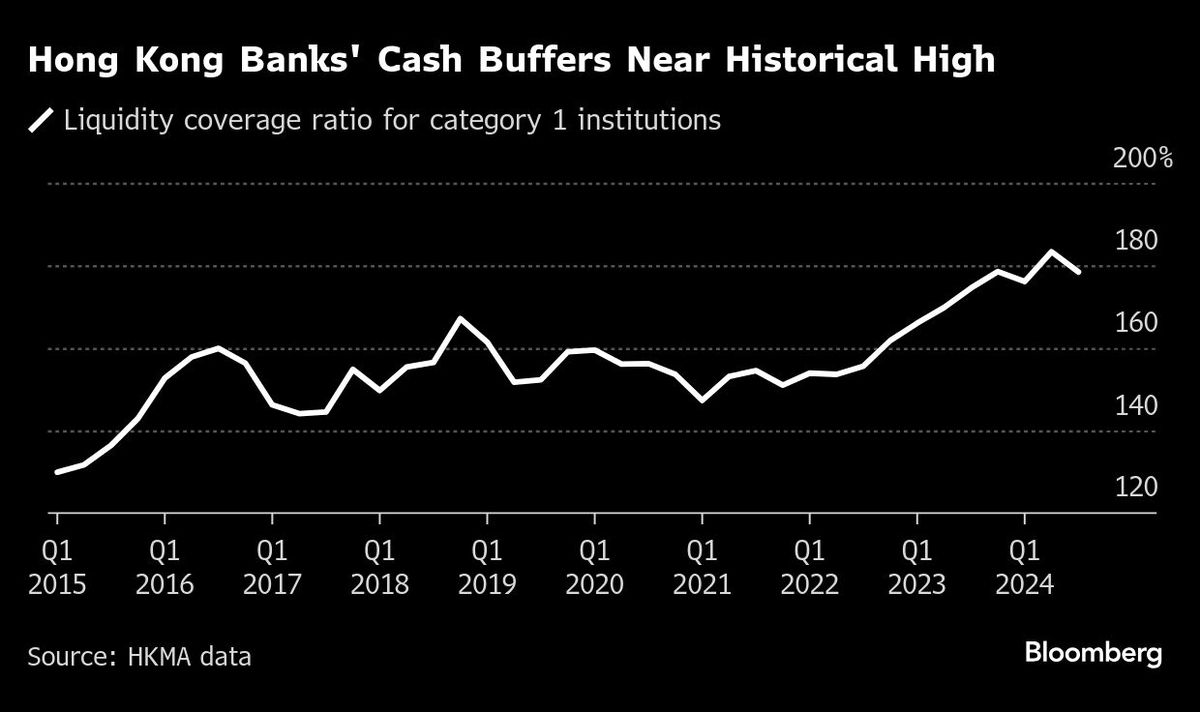
(Jan 8): Hong Kong banks are hoarding cash and liquidity despite calls by the government to help out struggling small businesses with funding to reignite the city’s ailing economy.
Banks in the city, including HSBC Holdings plc and Standard Chartered plc, held an aggregate liquidity coverage ratio of more than 180% in the second quarter, the highest ever and almost double the 100% requirement. The ratio — which gages liquid assets held to meet short-term obligations — eased slightly to 178.4% in September, according to the latest data from the Hong Kong Monetary Authority.
The cash hoard has raised concern with regulators as the economy struggles to regain traction after the pandemic years and political upheaval. The government, along with local banks, in August set up a task force to unleash small business funding and said it would “monitor” the business strategies of lenders.
On their end, banks say the cash positions are prudent given the sluggish economy and property downturn and that demand for loans is subdued after years of rising interest rates. Hong Kong’s currency is pegged to the US dollar, and its monetary policy follows the US central bank, which until last year had been raising rates.
“Businesses are struggling a lot, a lot are struggling to get finance,” said Benjamin Quinlan, the chief executive officer of consulting firm Quinlan & Associates. “The economic profile of Hong Kong is not great. Small and medium enterprises (SMEs) are critical to this city. Lending levels have been stagnant for the past five to six years.”
The 16 participating banks have set aside about HK$370 billion (US$48 billion or RM214.06 billion) in funds dedicated to small and medium enterprises, according to a spokesperson for the regulator.
In each of the first three quarters of last year, banks provided less than HK$300 billion in loans to the city’s whole sale and retail firms — a loose proxy for SMEs. That’s down from as much as HK$500 billion a quarter in 2014.
“The HKMA has been encouraging banks to strive to support the real economy including SMEs under the overarching principle of prudent risk management,” the spokesperson said.
Hang Seng Bank Ltd, which is controlled by HSBC, has the highest liquidity coverage ratio (LCR) by far among major lenders, clocking in above 300%. The lender has been hit hard by the city’s real estate slump, with impaired commercial real estate loans surging 12-fold in the first half of last year, according to Bloomberg Intelligence.
A spokeswoman for the lender said she was unable to comment.
It’s “more costly” for banks to underwrite loans to small- and medium-enterprises and the risks of lending outweighs the returns, according to Francis Chan, analyst at Bloomberg Intelligence.
Other lenders with high ratios included Bank of East Asia at 247% as of September 2024 and Bank of China (Hong Kong) at 231.8%.
A Bank of East Asia Ltd spokesman said the lender has been supportive of SMEs as it consistently keeps its LCR above regulatory requirements.
HSBC doesn’t publicly disclose the figure for its Hong Kong unit. A bank spokesman said historically, its liquidity metrics have been “well above” the regulatory minimum and the bank’s strong position enables it to continue to support customers.
Standard Chartered is dedicated to meeting clients financing needs, while its LCR reflects a prudent approach in liquidity management, according to a spokeswoman. Hong Kong remained its largest financing market and loans and advances to customers in the city showed mild year-on-year growth during the third quarter of 2024, she said.
Real estate
The excess liquidity is also due to the property downturn in China and Hong Kong commercial real estate. Many banks have “trimmed down” their exposure to both, which were a “key part” of their corporate lending, according to BI’s Chan.
HSBC, the biggest lender in the city, cut total mainland China real estate exposure to US$9.4 billion as of second quarter 2024, down from US$21.3 billion in the fourth quarter 2021. Some of that exposure was booked in Hong Kong. It also posted US$100 million of loan loss provisions for Hong Kong commercial real estate during the third quarter.
Its subsidiary Hang Seng Bank saw its credit impaired gross loans and advances to Hong Kong commercial real estate customers jump to HK$13.5 billion in first half of 2024, from HK$1.1 billion at the end of 2023.
Rival Standard Chartered plc reduced its exposure to China commercial real estate to US$2 billion as of September 2024, down by over 50% since end 2021. Its commercial real estate risks are limited, the spokeswoman said.
Loans and advances to customers made up around 35% of banks’ overall assets in November, down from around 41% in November 2021, representing a drop of about HK$1.11 trillion (US$140 billion), according to HKMA data.
“It’s pretty much a macro story that loan growth has been rather weak,” said Gary Ng, senior economist at Natixis SA, adding that there has been a “sharp decline” in loans in Hong Kong in the last three years, with a real estate downturn and people borrowing less for mortgages while companies are less optimistic.
Uploaded by Chng Shear Lane
- Bukit Aman calls up corporate figures to assist in investigations on MBI's money trail — sources
- Chemlite dips on ACE Market debut, extends listing flops
- Astro tests new record low as results disappoint, analysts flag uncertain future
- HK billionaire Lee Shau-Kee’s sons get control of US$10b Henderson stake
- Main-Market bound Cuckoo Malaysia prices IPO at RM1.29 a share
- MAG’s Boeing aircraft purchase was above board, says finance minister’s political secretary
- Bank of Japan's Ueda keeps his options open by reiterating policy stance
- Bitcoin rebound faces risk of ‘bull trap’ amid macro uncertainty
- British Airways to restart daily flights to KL on April 2 this year, says MAHB
- Trump now says he doesn’t want ‘too many’ exceptions in tariff push

